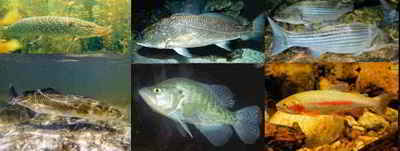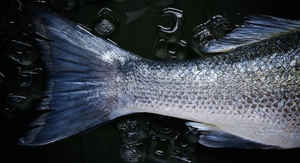
Oklahoma Symbols
Oklahoma State Fish
White Bass

(Morone chrysops)
Adopted on April 13, 1974.
Oklahoma designated white bass (Morone chrysops) as the official state fish in 1974. The White Bass, also called a Sand Bass, is dark blue-green on top, with silvery sides, a white belly and black horizontal stripes running along the length of its body.
Oklahoma State Fish: White Bass or Sand Bass

The white bass or sand bass (Morone chrysops) is a freshwater fish of the temperate bass family Moronidae. It is the state fish of Oklahoma.
It is an important game fish in much of North America below the Mason Dixon line in the United States. It's a small fish, but despite their moderate size, they are known for their fighting ability. The largest white bass ever caught weighed in at just over six pounds.
Characteristics of the White Bass
White bass are freshwater members of the temperate bass family Moronidae. Many of its members are marine fish, which includes striped bass. White bass are laterally compressed with olive or gray-blue above fading to silver or white on the sides. Stripes are gray, olive, or black and are not continuous below the lateral line. The mouth of a white bass is nearly vertical and relatively small. The tongue has only one tooth patch at its base. The soft dorsal fin is completely divided from the spiny dorsal portion.
Size
Adult white bass may reach 18 inches in prime habitats. However, most fish range between 6 and 14 inches. These fish grow relatively fast and rarely live more than 6 or 7 years.
Habitat
Associated with the pelagic (open water) areas of larger streams, rivers, and reservoirs.
Food
White bass are schooling fish (often segregated by size) that feed in the open water areas of rivers and reservoirs. Feeding occurs primarily during the crepuscular periods of the day (early morning and late evening). Location of prey is primarily visual and the school feeds as a large group driving the prey to the water's surface. Small white bass are opportunistic, near-shore feeders utilizing worms, mollusks, insects, fry, and crustaceans. Adults are more piscivorous and seek shad, shiners, and chubs, although they will eat larval insects when necessary.
Spawning
White bass spawn in the spring as water temperatures reach the middle 50's. Schools are separated by gender as fish seek creeks, shoals, or gravel
bars and begin to mingle. Females are larger than males and produce thousands of eggs. The female signifies readiness to spawn by darting to the surface.
Males follow the female and the spawning act occurs near the water's surface. The fertilized eggs drift in the current and are unattended by the parents.
Once hatched, the growth of the young is rapid.
Life Span:
6 - 7 years
Status
These fish are found throughout Kentucky in major streams, rivers and reservoirs. Some reservoir populations have declined following the introduction of striped bass and hybrid striped bass, a cross between white bass and striped bass.
Ecological Role
Initially, white bass were the top pelagic (open-water) predator in many of Kentucky's rivers and reservoirs. Competition between this species and its introduced relatives, the striped and hybrid striped bass, has negatively influenced its numbers. White bass in reservoirs without these competitors primarily feed on gizzard shad and their population numbers fluctuate in response to changes in abundance of this forage species.
Fun Facts
There is an old saying that the white bass make their spawning run when the Dogwood Tree blooms. Many anglers gauge their first white bass fishing trip by this saying. Most angling for these fish occurs in the spring as they make their way up reservoir tributaries or become concentrated below large river dams. White bass are also caught during the summer by anglers that find them concentrated along channel edges in reservoirs and in tailwaters below dams. A fun method of fishing for white bass is fishing the "jumps" during the late summer. Young gizzard shad are forced to the surface by white bass where a turbulent feeding frenzy occurs. Anglers catch white bass by coming near the feeding fish and throw spoons or jigs into the splashing melee. Another interesting way to fish for these fish in late summer is at night under a light at the lake's surface directed down into the water. Young shad move around the light and anglers catch white bass by fishing minnows in the circling mass of shad.
Oklahoma Senate Bill 323
Senate Bill No. 323
An Act designating the white bass as the official State fish; directing codification; and declaring an emergency.
Be it enacted by the People of the State of Oklahoma:
SECTION 1. State Fish
The white bass, Morone chrysops, sometimes know as sand bass, is hereby designated and adopted as the state fish of the State of Oklahoma.
SECTION 2. Codification
Section 1 of this act shall be inserted in the Oklahoma Statutes as Section 98.2 of Title 25 unless such number would result in duplication of numbers.
Approved April 13, 1974. Emergency.
Oklahoma Law
The law designating the white bass as the official Oklahoma state fish is Section 25.98.2 (State fish) of the Oklahoma Revised Statutes, Title 25 (Definitions and General Provisions) Chapter 3 (State Emblems and Honorary Positions) Section 25-98.2.
Title 25. Definitions and General Provisions.
Chapter 3 - State Emblems and Honorary Positions.
SECTION 25-98.2
§25-98.2. State fish.
The white bass, Morone chrysops, sometimes known as sand bass, is hereby designated and adopted as the state fish of the State of Oklahoma.
Laws 1974, c. 38, § 1, emerg. eff. April 13, 1974.
Taxonomic Hierarchy: White Bass
Kingdom: Animalia - animals
Phylum: Chordata - chordates
Subphylum: Vertebrata - vertebrates
Class: Osteichthyes
Order: Perciformes
Family: Moronidae
Genus: Morone
Species: Morone chrysops







